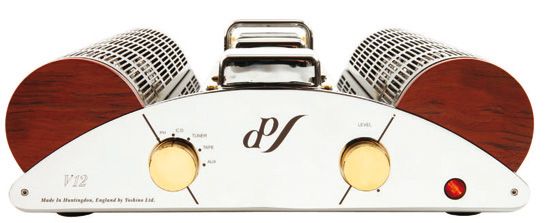Ear Yoshino V12 (£6690)

Although EAR-Yoshino founder, boss and designer Tim de Paravicini describes the new V12 integrated amplifier as a totally ‘clean sheet of paper design’, you can’t help but notice its resemblance to the V20. That amplifier sired this one, yet all that remains to cause confusion are identical dimensions and looks.
This time around, Tim wanted more still. ‘I wanted more grunt, a good, honest 50W/ch, and more extended tube life.’ He stuck with the ‘basic architecture of the V20, but I tweaked the circuit, the mechanical details, yet retained a similar family quality. What changed was the valve content.’ The result was that Tim replaced the V20’s 30 tubes with ten ECC83s and a dozen EL84s for the output tubes, mounted as six per channel.
So here we have an amplifier whose output valves are indirectly heated pentodes, still in a parallel push-pull Class A circuit but operating in pentode mode. Also remaining from the V20, of course, are Balanced Bridge Mode, the custom-made, ultra-wide bandwidth output transformers, and no overall feedback. It accommodates five line-level sources, with one input labelled ‘phono’ but requiring a phono stage, while outputs are restricted to one pair of sockets for tape. Tim positioned the bank of six speaker terminals across the top, at the back. These allow connection for 4 or 8ohm loads with separate sockets for either impedance. The front offers three controls: the EAR-Yoshino ‘signature’ orange power on/offbutton, a rotary volume control and a rotary source selector.
MUSICAL CHALLENGES
Listening to the opening of the remastered version of Band On The Run, the title track having a nasal nature all its own, enabled the V12 to show how it handled varying overlayed textures. Paul McCartney’s voice is smooth, almost muted on this track, while the synth-y whines, roiling bass, slow drums and hand claps, acoustic and jangly electric guitars – separated by wide-open stereo – present a challenge to any system with such a strong sonic personality.
The V12’s trick is to allow you to isolate these elements, so you can focus on any sound you care to, while ensuring that it all coalesces into something utterly coherent. Perhaps more surprising was that the same kind of coherence affected the most sparse recording I had to hand: Billie Holiday’s 1956 take on ‘My Yiddishe Momme’, in mono. It’s just Holiday, a piano, some friends. It’s not particularly spectacular in audiophile terms – a private, home recording never intended for release. But the V12 presented it as a cloud of music, in the middle of the room, with a visceral presence like driving in a fog: obscured but real.
Yet perhaps the most breathtaking display of the V12’s ability to balance finesse with power and authority came from the legendary Jimmy Scott’s performance on Black Sabbath: The Secret Musical History Of Black- Jewish Relations. His high voice, easily and often mistaken for a woman’s, turns the vocal theme from Exodus into a plea so plaintive that your heart will ache. Behind him is orchestration that’s sparse and subtle, lush but not overbearing strings, restrained bass, a bare hint of percussion or piano, the majesty coming solely from the vocal.
Thanks to its transparency and openess the V12 revealed every delicate nuance of a vocalist who defines ‘inimitable’, treating the recording it as if it were an honour and a privilege to reproduce it. In other words, it respects the music. But it takes no crap, either.
VERDICT
If you’ve lived with an EAR-Yoshino or EAR amp, you’ll recognise this as a de Paravicini design by the bass alone. It is deep, controlled and Amarone-dry, yet resolutely valve-y thanks to the warm midband that complements it. Though crammed with valves, it’s minimalist and no-nonsense, yet it oozes luxury. That’s my kind of schizophrenia.
Originally published in the Yearbook 2011



























































